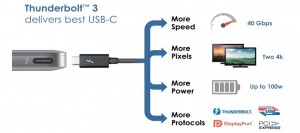
Intel sustine ca standardul USB-C are un potential foarte mare multumita versatilitatii sale, permitand incarcarea si transferul de date simultan, asta in timp ce ofera compatibilitate cu o multitudine de alte standard. Adaugand faptul ca un port USB-C este reversibil si are dimensiuni mici, Intel considera ca adoptarea sa pentru Thunderbolt 3 este o masura logica, astfel ca viitoarele laptop-uri vor avea porturi USB-C.
Thunderbolt was developed to simultaneously support the fastest data and most video bandwidth available on a single cable, while also supplying power. Then recently the USB group introduced the USB-C connector, which is small, reversible, fast, supplies power, and allows other I/O in addition to USB to run on it, maximizing its potential. So in the biggest advancement since its inception, Thunderbolt 3 brings Thunderbolt to USB-C at 40Gbps, fulfilling its promise, creating one compact port that does it all.
Multumita acestei implementari, prin USB-C vor putea fi transferate date la viteze de pana la 40 Gbps, deci teoretic orice fel de date ar trebui sa poata fi transferate la viteze foarte mari in aproape orice fel de conditii. Mai mult decat atat, portul este compact si permite conectarea unei multitudini de alte cabluri, deci utilizatorii nu vor avea probleme in a conecta monitoare, accesorii sau in a face incarcarea.
Nu se stie deocamdata cand vor fi lansate noi Mac-uri cu porturi USB-C, insa probabil pana la sfarsitul acestui an Apple va extinde implementarea si la noi produse, impreuna cu unele modificari de design.





















